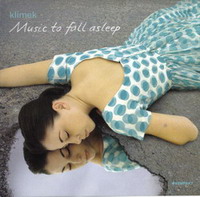 Sebastian Meissner (AKA Klimek) lives in Frankfort on the Main, Germany, he's a conceptual artist: composer, sounddesigner and photographer. He travels a lot, makes photos of interesting things, than think over the sound accompaniment for the life he had seen, topics, faces, feelings, emotions he had memorized. It is so, I'm sure. Besides the project Klimek, Sebastian cooperates with other musicians and releases his music under such names: Bizz Circuit, Random Inc. and Autopoieses.
Sebastian Meissner (AKA Klimek) lives in Frankfort on the Main, Germany, he's a conceptual artist: composer, sounddesigner and photographer. He travels a lot, makes photos of interesting things, than think over the sound accompaniment for the life he had seen, topics, faces, feelings, emotions he had memorized. It is so, I'm sure. Besides the project Klimek, Sebastian cooperates with other musicians and releases his music under such names: Bizz Circuit, Random Inc. and Autopoieses.Music To Fall Asleep is the second album of the musician. The mediator between the autonomous creator Klimek and the rest of the world is the sound-recording firm Kompakt situated in Cologne. By the way this album was the 50th one in the release-list of Kompakt.
Let's imagine that we already have the album, hold it in our hands, just brought from the shop (obligatory licensed one belonging to the distribution network of the sound-recording firm Kompakt). So we brought it home. Hold it in our hands, examine the disc and understand that it's absolutely wonderful, even perfect. With what starts the acquaintance with a new album? You are right, with its cover. As usual, we take the loose leaf out of the box, examine it, even smell it - unique aroma of the offset paint, the print of the loose leaf is of very high quality. Professional graphic design, blue-gray tones, erose asphalt, polka-dot dress, sleeping beauty - everything is joined together by the general concept. The title of the album is stylized to the chalk sign on the asphalt. General mood of the compositions - neutral thoughts with a slight tinge of surrealism and comfort shivering of incompleteness. It's not just photo, it's photo-art, independent artwork (photographer - Sabine Siegmund). So the cover of the album makes us meditate, as it happens not so often nowadays. And at last we take the disc, put it to the player and push the 'Play' button.
The body of the album consists of 12 tracks-compositions mixtured with each other without any pauses, so that we listen to an integrated metacomposition 65 minutes long, divided into several parts for convenience. So listening of the album with random sampling has no sense. Obeying the general concept the tracks slowly replace each other, besides they have very odd titles... Yeah, high time to turn the box upside-down and read the titles. Great Idea again - the whole album is like the model of conceptual creative work. Notional fragments of the titles are marked out by different colors in English and German.
The inscripts seem to be handmade and the blue ones are made in another print like in the samples of writing. Yeah, it definitely gives some thoughts. I think that it's profanity to fall asleep listening to such music,especially when it's created not for such a purpose. Personally for me it's easy to fall asleep by music when you are too tired. And in the cases when music consists of regular, repetitive structures - groove, bass line, thoughtful, warm synthesizer backings like Enigma, for example: Far more interesting is the fact that this disc doesn't include anything of that kind. Klimek develops and improves the sounding created by people from Kompakt's mafia, they called it 'Pop Ambient' - ambient for a wide audience. Well, they didn't create anything new and original, such ambient exists already for a long period of time, the works of Pete Namlook and musicians from the label Fax are approximately of the same style. 2001 Kompakt released the CD compilation under the title 'Pop Ambient' creating at the same time the relevant trend. Starting from those times this firm releases one compilation of 'Pop Ambient' every year and all of them are worth listening, at least for the listeners to be well-informed about the new names and events.
Basic instruments used in the album are guitar (acoustic and electric ones), piano, contrabass and something undistinguishable. Friendly speaking there are not much of them. In some compositions we hear only one instrument, of course, that's hard to believe it, but that's true. Klimek uses the software of Native Instruments (Reaktor, Absynth), makes the genetic modification of alive instruments' sound and the changes of aggregate states. A guitar chord goes through the phase of reverse engineering, it pulverizes into tiny pieces, then reconstructs because of the use of accidentially chosen algorithm. As a result we hear something unblievable, weightless colloidal substance or acoustic spray. The sound forms tangible clouds thickening above the scene created in our imagination. After that the clouds condense into droplets, we turn to the next rotation cycle, the new, unique one.
That's why the album is really charming. Altogether it is like the string orchestra inside the environment of changeable quantity of 'sound refraction'. As a result the wave-forms behave in a strange way. Some people use to call it indie folk, independent folk. That's understandable as the sound is unfamiliar, extraordinary, and in general such music is still not acceptable for wide masses, but nevertheless there isn't a hint of folk. It's not that 'new electronic music', the sound mostly resembles electroacoustics. The mood of the album can't be called weakening and relaxating, vice versa it stimulates your thoughts and imagination, it makes your brain form the analytical models and make calculations.
Maybe some time in the future we'll be able to fall asleep by such music.
- Sebastian Meissner
- Kompakt
